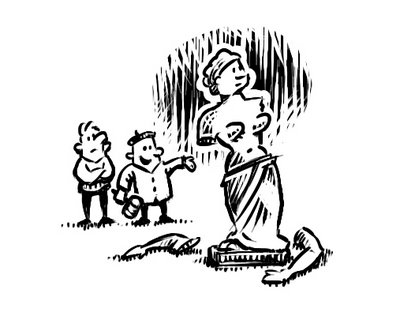 As stated previously, somebody might argue that for something to be Art it must be recognizable. The rock carved into the shape of David looks like a man. The song Still Haven’t Found What I’m Looking For by rockers U2 has a recognizable melody and follows rules set forth for pop music. The movie Dirty Dancing has a beginning, middle, and an ending where no one puts Baby in a corner. We understand these things.
As stated previously, somebody might argue that for something to be Art it must be recognizable. The rock carved into the shape of David looks like a man. The song Still Haven’t Found What I’m Looking For by rockers U2 has a recognizable melody and follows rules set forth for pop music. The movie Dirty Dancing has a beginning, middle, and an ending where no one puts Baby in a corner. We understand these things.
 David, Michelangelo; Walking Man II, Alberto Giacometti, (1948) Bronze; Lascaux Cave drawing
David, Michelangelo; Walking Man II, Alberto Giacometti, (1948) Bronze; Lascaux Cave drawing
Well, they all do. Obviously Michelangelo’s David is the most anatomically correct. But if we use that as the measure for what makes it a work of Art, even poor Dave fails that test.
How’s that? Well, as much as we can discern that Michelangelo’s statue of David is representative of a man, he’s far from anatomically correct. His head is out of proportion to his body, his hand is too large. For that matter his marble flesh isn’t even the right color, unless he’s an albino. How can he be considered a work of Art by these criteria any more than the other less anatomically correct figures in the pictures above?
He can’t. Where do you draw the line? How far away from reality can the work veer before we say it no longer represents a man? And when it’s at that point what does it then represent? Who can even know what the figure represents at any point? Only one person can.
The artist.
There’s a problem with foisting rules on somebody else’s creation before it can be labeled Art. We don’t always know what meaning the artist gives to his work when he creates something.
In the examples above, each figure clearly represents a human form. David is specifically representative of the hero from the Bible. Giacometti’s Walking Man II isn’t representative of anybody in particular, it’s that it’s a person striding forward that’s important. And in the Lascaux cave painting we can only surmise that the figure represents a man hanging with the birds and beasts, but whether he’s specifically meant to be Chaka the cave boy with his wiener hanging out or nobody in particular, isn’t known to us - because we don’t know the painter’s intentions.
The one thing that determines whether an object is a work of art or not is the intentions of the person making it.
A painting doesn’t exist on a graded scale that, once it reaches a point farthest from something else we like to call Art, can just be knocked off the shelf. There’s no sharp line that divides one piece of Art from another. It’s only the intentions of the sculptor or painter or composer that determines if what they create is Art. And we have to trust them when they tell us their intentions, the thing that gives their Art its meaning. Otherwise, how would we know if it’s their interpretation of their own universe?
Don’t believe it? Ask a painter what she thinks her painting is about. When she explains it to you try to tell her that she’s wrong. Really, she’s wrong? How can we know better than the artist what her Art is about? So when Barnett Newman paints a flat red field on a canvas and places a white line neatly down the middle of it and calls it Art, we have to take his word for it because he knows his own intentions. It just helps a lot when we understand what those intentions are, too.
So when Barnett Newman paints a flat red field on a canvas and places a white line neatly down the middle of it and calls it Art, we have to take his word for it because he knows his own intentions. It just helps a lot when we understand what those intentions are, too.
That doesn’t mean you have to like it though.
“If someone creates something and calls it art, then fine, (s)he is an artist. There’s no qualifications or degrees necessary for the title.”
John Nagridge , Yeah, but is it Art
Next time: Information Desk

Quoting me, as though I'm an authority? LOLOLOL You've lost all credibility now!!!!
ReplyDeleteIt was such a good quote though. You think I've lost credibility? Wait until you see who else I reference.
ReplyDeleteOh no. You're going to quote an elephant.
ReplyDelete